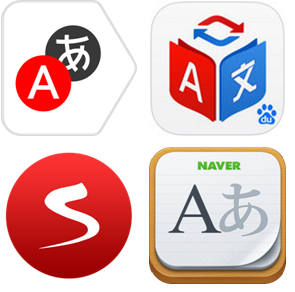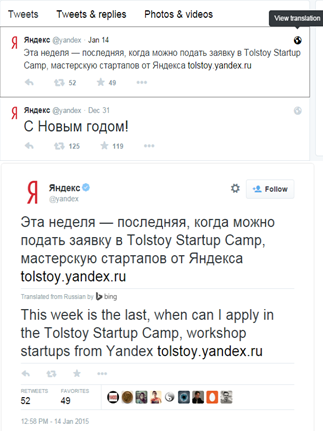
In the last three months there has been a great media focus on machine translation technology and applications offered by some of the big names in international search. To name a few, Google Translate version 3.1.0 and Skype Translator, as well as Bing Translator re-joining forces with Twitter. This post aims to summarise the main advancements in recent months, and examine the effect that this takeover of the search engines will have on the translation industry.
The search engine translation takeover
Unless you have been living under a rock since the New Year I can guarantee that you will have heard about the latest updates to the Google Translate mobile application. Greeted with mixed reviews, and controversy along the way, Google Translate has increased its functionality by incorporating the technology of Word Lens, bought from US developers Quest Visual in mid-2014. Using augmented reality, the integration of Word Lens allows users of the app to translate text on the go without even needing a data connection.
This particular feature allows users to use their handset’s camera to take a photo of text, or have text automatically overlaid with the translation, in seven languages (English, French, Italian, German, Spanish, Portuguese and Russian, more to follow). As the image above shows, this feature is expected to be particularly useful for tourists who want to get around new places with ease whilst travelling. However, a test run carried out by Web-Translations demonstrated how this particular functionality was only really helpful when translating simple signs, and still threw out some dodgy ingredients when used to decipher a foreign menu.
The second new addition to Google’s app is the “pocket interpreter” function which allows users to interact with speakers of other languages via Speech Recognition (SR) and Text-to-Speech (TTS) technology. With surprising results this area of the app seems to be working relatively well despite the complex processes involved to translate even the simplest spoken phrase. As soon as the app was launched, The Guardian put it to work in Times Square, New York, one of the busiest tourist spots in the world. Check out the video here to see the app work its magic.
You might be wondering, “Where exactly do the translations come from?” Like all Google’s translation offerings the translations are generated through Google’s machine translation (MT) database which also powers the online browser version of the application. As demonstrated by the tests shared above the accuracy of the translations varies considerably from language to language, simple vs. complex sentence structure, and amount local nuances and terminology; all typical issues which arise when using MT tools.
But it is not just Google who have expanded into translation! In fact the six biggest names in international search all have their own online translation services using MT technology.
The table below illustrates the number of languages which are currently available through the facilities offered by the “Big Six”:

Like any MT tool there has to be a huge amount of training involved in order to keep the tool learning, developing and expanding its “vocabulary”. No MT system is perfect, so it is down to human post-editing to tighten up the syntax, grammar and local nuances which are not generated or captured through automated machine translation processes. That said, it is these tools which are gradually being integrated into daily life through browser plug-ins, mobile applications and even social networking.
The world of social media and machine translation
Bing Translator is also in the habit of getting as many fingers into as many pies as possible with the launch of Skype Translator preview and Twitter translation in the last two months. Like Google Translate, Skype Translator has drawn a lot of media attention through its incorporation of SR and TTS within its telecommunications application. Although currently in a preview-mode, and only offering English and Spanish initially, Skype Translator allows users across the globe to communicate with their interlocutors in their own native language. Here is a heart-warming video showing school children from Mexico speaking with a school in the United States that demonstrates the simplicity, and effectiveness, of the application.
Using Bing Translator, Skype also enables Instant Messages to be automatically translated into the language of the user. Microsoft hope to roll-out both features across the application in over 40 languages but they are still a little way off from being able to do so. Let’s see how this initial phase goes.
The social media site Twitter has also partnered with Bing to offer translation services to “Tweeters” all over the world in order to expand their network and communicate with their followers overseas. Initially trialled during the 2014 World Cup in Brazil, but quickly disabled afterwards, Bing Translator is back and can easily be set-up in a user’s profile settings.
By clicking the globe in the top right-hand corner of any tweet, Bing Translator will provide users with a generated translation, which, although not always accurate, allows them to catch the gist of what is been tweeted.
Impact of the search engine takeover
As you can see from this quick summary, in recent months we have seen several of the world’s search engine powers expand their reach into the world of translation through their use and development of machine translation technology and tools, but what does this mean for the world of translation and digital marketing?
Translation agencies and language service providers across the global are slowly having to shift their focus to machine translation (MT) and its increasing use as a “quick and dirty” approach to translation. Although there is little chance of human translators being put out of their jobs, it is becoming more important than ever to spread the gospel of high quality, human translations to the masses. More and more agencies are offering reviews and post-editing of MT in order to help their clients improve the quality of their translated content in order to make it sound “more human”.
The same applies to international search and digital marketing. More and more businesses are resorting to quick and cheap MT to translate their site, but then want to generate interest overseas through SEO, PPC and social media. Let’s get one thing straight though, spending money on an international PPC campaign that drives traffic and effectively new business, to a machine translated landing page will not do you any favours; the same goes for on-page optimisation. Using the Google Translate plug-in does not allow for any on-page optimisation at all due to its automated nature, whilst content translated by machine and then imported back into a site will meet problems when you ask an agency to conduct a page content review, inserting keywords into content which may not make any sense syntactically or grammatically.
MTPE

You may use machine translation as part of your localisation strategy and in such an instance, it is advisable that you include an element of human post-editing where the machine-generated content will be reviewed and amended where possible by one of our professional translators. You will receive your post-edited machine translation, in your desired format and ready for use.
Sponsored
Let’s not forget that Google also penalise websites where MT is clearly being used on a mass basis, pushing them lower in SERPs due to their poor linguistic quality.
Of all of the machine translation technologies described here I would say that the only real benefit that they have is for the general public to navigate their way whilst exploring new lands overseas, to communicate with their Great-Aunt on the other side of the world, or to find out the latest news happening in real-time. Yes, I have used Google Translate, but only to get a quick, and very top-level, understanding of something I have stumbled across online. Would I use these tools from a business perspective? Perhaps not. The only tool I imagine I could use in a professional setting would be Skype Translator to liaise with translators, validators and international clients in their own native language but we are a very long way away from that.
I would love to hear your thoughts and experiences using these machine translation tools, and what you think about the search engine translation takeover I have described. In the meantime, here is a video that shares the dangers of using machine translation as part of your international marketing strategy.

Emily MacKenzie
Latest posts by Emily MacKenzie (see all)
- What is SEO-localisation? - May 11, 2018
- Agile processes for continuous delivery: A focus on SEO-localisation - May 11, 2018
- E-book review: Undertaking SEO-localisation in a world of continuous delivery - May 11, 2018







